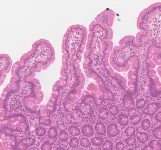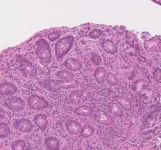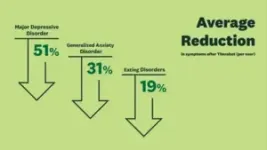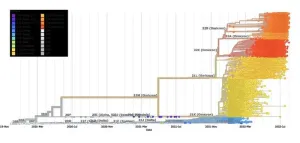(Press-News.org) A machine learning algorithm developed by Cambridge scientists was able to correctly identify in 97 cases out of 100 whether or not an individual had coeliac disease based on their biopsy, new research has shown.
The AI tool, which has been trained on almost 3,400 scanned biopsies from four NHS hospitals, could speed up diagnosis of the condition and take pressure off stretched healthcare resources, as well as improving diagnosis in developing nations, where shortages of pathologists are severe.
Digital tools that can speed up or even automate analysis of diagnostic tests are beginning to show real promise for reducing the demands on pathologists. A large amount of this work has focused on the detection of cancer, but researchers are beginning to look at opportunities to diagnose other types of disease.
One condition being looked at by scientists at the University of Cambridge is coeliac disease, an autoimmune disease trigged by consuming gluten. It causes symptoms that include stomach cramps, diarrhoea, skin rashes, weight loss, fatigue and anaemia. Because symptoms vary so much between individuals, patients often have difficulty in receiving an accurate diagnosis.
The gold standard for diagnosing coeliac disease is via a biopsy of the duodenum (part of the small intestine). Pathologists will then analyse the sample under a microscope or on a computer to look for damage to the villi, tiny hair-like projections that line the inside of the small intestine.
Interpreting biopsies, which often have subtle changes, can be subjective. Pathologists use a classification system known as the Marsh-Oberhuber scale to judge the severity of a case, ranging from zero (the villi are normal and the patient is unlikely to have the disease) to four (the villi are completely flattened).
In research published today in the New England Journal of Medicine AI, Cambridge researchers developed a machine learning algorithm to classify biopsy image data. The algorithm was trained and tested on a large-scale, diverse dataset consisting of over 4,000 images obtained from five different hospitals using five different scanners from four different companies.
Senior author Professor Elizabeth Soilleux from the Department of Pathology and Churchill College, University of Cambridge, said: “Coeliac disease affects as many as one in 100 people and can cause serious illness, but getting a diagnosis is not straightforward. It can take many years to receive an accurate diagnosis, and at a time of intense pressures on healthcare systems, these delays are likely to continue. AI has the potential to speed up this process, allowing patients to receive a diagnosis faster, while at the same time taking pressure off NHS waiting lists.”
The team tested their algorithm on an independent data set of almost 650 images from a previously unseen source. Based on comparisons with the original pathologists’ diagnoses, the researchers showed that the model was correct in its diagnosis in more than 97 cases out of 100.
The model had a sensitivity of over 95% - meaning that it correctly identified more than 95 cases out of 100 individuals who had coeliac disease. It also had a specificity of almost 98% - meaning that it correctly identified in nearly 98 cases out of 100 individuals who did not have coeliac disease.
Previous research by the team has shown that even pathologists can disagree on diagnoses. When shown a series of 100 slides and asked to diagnose whether a patient had coeliac disease, did not have the disease, or whether the diagnosis was indeterminate, the team showed that there was disagreement in more than one in five cases.
This time round, the researchers asked four pathologists to review 30 slides and found that a pathologist was as likely to agree with the AI model as they were with a second pathologist.
Dr Florian Jaeckle, also from the Department of Pathology, and a Research Fellow at Hughes Hall, Cambridge, said: “This is the first time AI has been shown to diagnose as accurately as an experienced pathologist whether an individual has coeliac or not. Because we trained it on data sets generated under a number of different conditions, we know that it should be able to work in a wide range of settings, where biopsies are processed and imaged differently.
“This is an important step towards speeding up diagnoses and freeing up pathologists’ time to focus on more complex or urgent cases. Our next step is to test the algorithm in a much larger clinical sample, putting us in a position to share this device with the regulator, bringing us nearer to this tool being used in the NHS.”
The researchers have been working with patient groups, including through Coeliac UK, to share their approach and discuss with them their receptiveness to technology such as this being used.
“When we speak to patients, they are generally very receptive to the use of AI for diagnosing coeliac disease,” added Dr Jaeckle. “This no doubt partly reflects their experiences of the difficulties and delays in receiving a diagnosis.
“One issue that comes up frequently with both patients and clinicians is the issue of ‘explainability’ – being able to understand and explain how AI reaches its diagnosis. It’s important for us as researchers and for regulators to bear this mind if we want to ensure there is public trust in applications of AI in medicine.”
Professor Soilleux is a consultant haematopathologist at Cambridge University Hospitals NHS Foundation Trust. Together with Dr Jaeckle, she has set up a spinout company, Lyzeum Ltd, to commercialise the algorithm.
The research was funded by Coeliac UK, Innovate UK, the Cambridge Centre for Data-Driven Discovery and the National Institute for Health and Care Research.
Keira Shepherd, Research Officer at Coeliac UK, said: “During the diagnostic process, it’s vital that patients keep gluten in their diet to ensure that the diagnosis is accurate. But this can cause uncomfortable symptoms. That's why it's really important that they are able to receive an accurate diagnosis as quickly as possible.
“This research demonstrates one potential way to speed up part of the diagnosis journey. At Coeliac UK, we’re proud to have funded the early stages of this work, which initially focused on training a system to differentiate between healthy control biopsies and biopsies of patients with coeliac disease. We hope that one day this technology will be used to help patients receive a quick and accurate diagnosis."
“Anything that makes the system quicker must be a good thing” – Liz Cox, 80
Liz Cox, 80, had been having symptoms including anaemia and stomach pains for almost 30 years when a question from a friend – “Are you still losing weight?” – made her realise that she ought to seek help.
Born in Tottenham, North London, towards the end of the Second World War, Liz has moved around, spending part of her life in Singapore after getting married before settling down to live in Linton, just outside Cambridge. She had spent most of her life working in libraries and took up a “retirement job” working in Linton’s community library.
Liz began with severe stomach pains in her 30s, after having her three children.
“My doctor carried out various tests, but coeliac disease wasn't very well known then, so I wasn't tested for that. I was quite tired, but I just carried on because you have to when you've got three children and a husband, don't you?”
Liz tried not to let her condition get in the way, making sure she found time for activities she enjoyed, such as skiing and dancing, and it wasn’t until her late 50s, prompted by her friend’s question, that she went back to the doctor.
This time, her GP in Linton did a blood test, which suggested advanced coeliac disease. A biopsy at Addenbrooke’s Hospital confirmed this – but also found pre-cancerous cells.
“I used to see Dr Jeremy Woodward, my consultant, every year for an endoscopy. Wasn't I lucky!” she says. After about 10 years, she was given the all-clear for cancer and discharged.
Since her diagnosis, Liz has been on a strict, gluten-free diet, which had an effect almost immediately. She isn’t tempted to have even the smallest amount of gluten now.
“Some people say, ‘Have a little bit’, but no, it's a strict diet, because you don't know what it's doing to your insides. It's just mind over matter, isn't it? You can't have it, end of story.”
She joined a Coeliac UK support group in Bury St Edmunds, which helped her meet others like herself, share tips and find good places to eat that did gluten-free options. She was talked into becoming the Secretary, with her husband agreeing to become Membership Secretary – they have been doing this now for 20 years.
It was through this group that Liz met Professor Elizabeth Soilleux from the University of Cambridge.
“Elizabeth came to our meeting to talk about her research. It was quite fun because she showed us pictures of biopsies and said could we guess which were coeliac and which weren’t? It wasn't easy.”
Liz is impressed with the use of AI to diagnose coeliac disease. Her referral for an endoscopy and the subsequent diagnosis happened relatively quickly. Not everyone is as fortunate.
“You hear stories from other people, and they've waited a long time. They go back and forward to the doctor's often, with various odd symptoms, and perhaps the doctors don't always test them for that.
“Anything that makes the system quicker must be a good thing, because once you've been diagnosed and you know you can't have gluten, then you know what to do, and you feel so much better.”
Reference
Jaeckle, F, Denholm, J & Schreiber, B. Machine Learning Achieves Pathologist-Level Coeliac Disease Diagnosis. NEJM AI; 27 March 2025; DOI: 10.1056/AIoa2400738
END
AI is as good as pathologists at diagnosing celiac disease, study finds
2025-03-27
ELSE PRESS RELEASES FROM THIS DATE:
AI could help sonographers identify abnormalities in unborn babies more quickly
2025-03-27
Artificial intelligence (AI) could help sonographers identify any abnormalities at the 20-week pregnancy screening scan almost twice as quickly, without reducing the accuracy or reliability of diagnoses, a new study has shown.
This will help improve patient care by allowing sonographers to focus on other aspects of the scan, such as communicating with parents or spending more time looking at any areas of concern.
The trial is the first of its kind to use AI for the 20-week pregnancy scan on real patients, and is ...
First clinical trial of an AI therapy chatbot yields significant mental health benefits
2025-03-27
Dartmouth researchers conducted the first clinical trial of a therapy chatbot powered by generative AI and found that the software resulted in significant improvements in participants' symptoms, according to results published March 27 in the New England Journal of Medicine AI.
People in the study also reported they could trust and communicate with the system, known as Therabot, to a degree that is comparable to working with a mental-health professional.
The trial consisted of 106 people from across the United States diagnosed with major depressive disorder, generalized anxiety disorder, or an eating disorder. ...
AI learns to ‘speak’ genetic ‘dialect’ for future SARS-CoV-2 mutation prediction
2025-03-27
It’s been five years since COVID-19 was declared a global pandemic. As SARS-CoV-2 shifts to endemic status, questions about its future evolution remain. New variants of the virus will likely emerge, driven by positive selection for traits such as increased transmissibility, longer infection duration and the ability to evade immune defenses. These changes could allow the virus to spread among previously immunized populations, potentially triggering new waves of infection.
Predicting new mutations in viruses is crucial for advancing life science research, particularly when trying to understand how viruses evolve, ...
$50 million gift from the Weill Family Foundation establishes the Weill Cancer Hub East
2025-03-27
New York, N.Y., and Princeton, N.J. (March 27, 2025)—With a mission to understand how nutrition and metabolism impact the body’s ability to control cancer, four leading research institutions have united under the Weill Cancer Hub East, an innovative, collaborative partnership that aims to transform cancer treatment. The initiative connects world-class experts from Princeton University, The Rockefeller University, Weill Cornell Medicine and the Ludwig Institute for Cancer Research to enhance a ...
Physics meets art: a new twist on interference patterns
2025-03-27
Tokyo, Japan – One of the simplest and most beautiful naturally occurring patterns can be observed when light is shined through a pair of slightly misaligned periodic structures. This phenomenon, known as the moiré effect, is not only pretty to look at, but also has important consequences for the properties of materials.
In an article published in ACS Nano, a team led by researchers from the Institute of Industrial Science, The University of Tokyo, announced the discovery of a previously unseen moiré pattern: a series of periodic one-dimensional bands in tungsten ditelluride bilayers.
In nanomaterials, moiré patterns ...
Elevating global heart failure care with new certification
2025-03-27
DALLAS, March 27, 2025 — More than 56 million people globally live with heart failure (HF), which prevents the body from getting enough of the oxygen-rich blood it needs to work properly.[1]
While there is no cure for HF, many people with this condition can live full, enjoyable lives and disease progression can be slowed with the right treatment. Research shows that outcomes for patients with HF improve when health care professionals and hospitals provide guideline-directed medical therapies.
A new Heart Failure Center ...
The MIT Press releases 2025 Direct to Open (D2O) Impact Report
2025-03-27
The MIT Press is proud to release our 2025 Impact Report for Direct to Open (D2O), our sustainable framework for open access monographs that shifts publishing from a solely market-based purchase model where individuals and libraries buy single eBooks, to a collaborative, library-supported open access model.
The continued growth in the reach of open access publishing couldn’t be more timely. In 2025, access to truth and facts are under attack, and democratizing access to trustworthy, peer-reviewed information has never been more important. In the face of so many forces working against the spread of knowledge, Direct to Open continues to be a critical tool.
To date, ...
New study reveals the curative potential of genome editing approach for genetic deafness
2025-03-27
Congenital hearing loss refers to impaired auditory function that occurs due to genetic causes. GJB2 is the gene responsible for approximately half of all cases of hereditary hearing loss. Connexin 26 (CX26), which is encoded by GJB2, helps in the formation of intercellular gap junctions—channels that allow for the movement of ions and chemical messenger molecules between adjacent cells, where it regulates auditory function.
GJB2 mutations often lead to fragmentation of gap junctions and gap junction plaques (GJPs) which are composed ...
AAAS elects Keck School of Medicine of USC molecular biologist Yali Dou as 2025 fellow
2025-03-27
Molecular biologist Yali Dou, PhD, holder of the Marion and Harry Keiper Chair in Cancer Research and professor of medicine and cancer biology at the Keck School of Medicine of USC, has been elected a fellow of the American Association for the Advancement of Science (AAAS). She is one of seven USC faculty members in the 2025 cohort of new fellows.
The AAAS is the world’s oldest and largest general science organization and the publisher of Science, a top peer-reviewed academic journal. Election as a fellow is a lifetime honor — one of the AAAS’s ...
Damaging cluster of UK winter storms driven by swirling polar vortex miles above Earth
2025-03-27
University of Leeds news
Embargoed until 10:00 GMT, 27 March
Damaging cluster of UK winter storms driven by swirling polar vortex miles above Earth
Powerful winter storms which led to deaths and power outages in the UK and Ireland were made more likely by an intense swirling vortex of winds miles above the Arctic, say scientists.
A team of researchers led by the University of Leeds has pinpointed a new reason for winter storm clusters such as the trio named Dudley, Eunice and Franklin, which hit the nation within the space of a week in February 2022.
The findings which are published today in the journal ...








